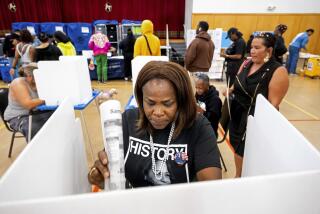PICKING A PRESIDENT : THE ELECTORAL COLLEGE IN ACTION
- Share via
The President and vice president are the nation’s only elected officials who do not gain office by direct vote of the people. When Americans cast their ballots in the presidential race, they are actually voting for “electors” pledged to their candidate. The number of each state’s electors is the total of its two Senate seats and its House seats. These electors, who constitute the Electoral College, make the actual selection for President. The development of political parties has made the system largely ceremonial. Here is a look at how it works:
1. Each party within a state selects a group of electors for each candidate--mostly party loyalists.
2. When Americans vote Tuesday, they will actually be voting for the slates of electors pledged to their candidates. In all but two states, a winner-take-all system is used: The candidate who wins the most votes in a state gets all of its electors.* Thus, even if a candidate wins California by only one vote, he is awarded all of its 54 electoral votes. To win the presidency, a candidate must receive 270 electoral votes.
3. On Dec. 14, in a mostly procedural step, the electors will meet in their respective state capitals to cast their votes.
4. On Jan. 6, the president of the Senate will open certificates containing the votes.
If they don’t reach 270: If no candidate receives 270 electoral votes, the House selects the winner. Each state would get one vote, cast as a majority of its representatives chooses.
The system’s purpose: The framers of the Constitution set up the Electoral College after rejecting direct elections as well as a proposal that Congress choose the nation’s leader. The compromise was this system of indirect vote.
Trivia time: Two candidates have been elected directly despite receiving fewer popular votes than their opponents: Rutherford B. Hayes in 1876 and Benjamin Harrison in 1888.
* Maine and Nebraska use a slightly different system to award electoral votes.
AN ELECTION NIGHT SCORECARD
A majority of the electoral vote, 270, is required to win the presidency. Here’s a scorecard for tracking Tuesday’s night’s winner:
Electoral votes / Clinton / Bush / Perot Alabama: 9 Alaska: 3 Arizona: 8 Arkansas: 6 California: 54 Colorado: 8 Connecticut: 8 Delaware: 3 District of Columbia: 3 Florida: 25 Georgia: 13 Hawaii: 4 Idaho: 4 Illinois: 22 Indiana: 12 Iowa: 7 Kansas: 6 Kentucky: 8 Louisiana: 9 Mississippi: 7 Maine: 4 Maryland: 10 Massachusetts: 12 Michigan: 18 Minnesota: 10 Missouri: 11 Montana: 3 Nebraska: 5 Nevada: 4 New Hampshire: 4 New Jersey: 15 New Mexico: 5 New York: 33 North Carolina: 14 North Dakota: 3 Ohio: 21 Oklahoma: 8 Oregon: 7 Pennsylvania: 23 Rhode Island: 4 South Carolina: 8 South Dakota: 3 Tennessee: 11 Texas: 32 Utah: 5 Vermont: 3 Virginia: 13 Washington: 11 West Virginia: 5 Wisconsin: 11 Wyoming: 3 Totals:
More to Read
Get the L.A. Times Politics newsletter
Deeply reported insights into legislation, politics and policy from Sacramento, Washington and beyond. In your inbox twice per week.
You may occasionally receive promotional content from the Los Angeles Times.









